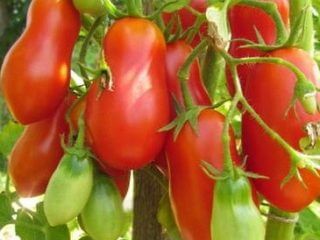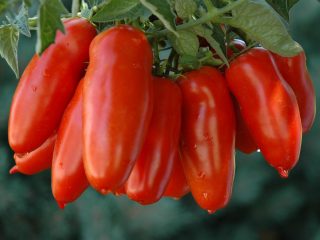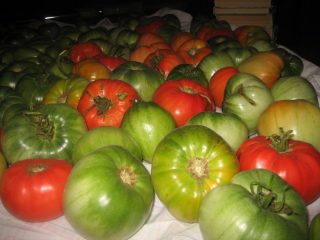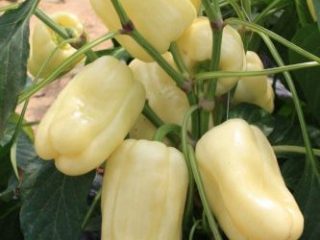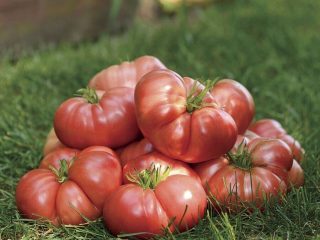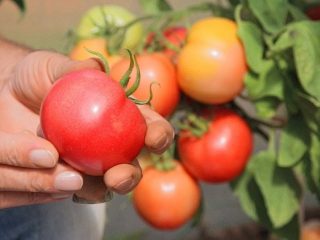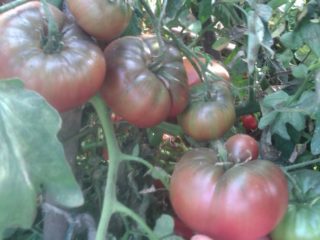Content
Tomato Tatyana is a high-yielding, early-ripening variety of Russian selection, suitable for growing in greenhouses and open ground. It is valued for the smooth ripening of fruits and its compactness, which saves space in the garden.
When and how did it appear
The tomato variety was bred at the end of the last century by employees of the Federal State Budgetary Institution of Science Institute of General Genetics named after. N. Vavilova. A group of scientists worked on its creation, which included T. Arkhipova, Y. Altukhov, V. Mikhed and V. Zhidkova. In 2000, the variety was included in the State Register of the Russian Federation and allowed for cultivation in small farms, gardens and household plots.

The Tatyana variety is not a hybrid, unlike Tanya F1, with which it is often confused
Description and characteristics of tomatoes variety Tatyana
The plant is a compact, low-growing bush of determinate type. Its strong, erect, highly branched stems are covered with multiple green leaves of medium size and extend to a maximum of 60 cm.

The first inflorescence of tomatoes is laid above the 6-7 leaf, the subsequent ones - after 1-2 plates
In each transitional type cluster, 4-8 tomatoes ripen. The fruits have a flat-round shape with slight ribbing at the stalk, covered with a glossy thin and dense skin, the color of which depends on the degree of ripeness. In unripe specimens it is green, in ripe specimens it is deep red. The lower tomatoes weigh 170-200 g, the rest - 103-120 g. The fleshy, juicy, non-watery pulp of tomatoes has a pleasant taste with subtle fruity notes and contains a large amount of sugars and dry substances.
Ripening and fruiting
Tomato Tatyana is classified as an early ripening variety. Tomatoes ripen in 108-109 days from the moment of mass emergence. When grown in the southern regions, the fruits ripen in 90-98 days.
Tomato productivity Tatyana
The tomato variety belongs to the highly productive category. The average yield of Tatyana tomatoes is 4.7-5.1 kg/m2.
Disease resistance
Tomato Tatyana is characterized by good immunity and is immune to certain “tomato” diseases. In particular, the tomato variety has increased resistance to late blight.
Where is it grown?
The Tatyana tomato is successfully grown throughout almost the entire territory of the Russian Federation. It is recommended for planting in the Far Eastern, East Siberian, West Siberian, Ural, Lower Volga, Middle Volga, North Caucasus, Central Black Earth, Volga-Vyatka, Central, Northwestern and Northern regions.
Purpose and application
Tomato Tatyana is classified as a universal variety for table use. Its medium-sized juicy fruits have a pleasant sweet taste and do not crack during long-term storage.Tomatoes are consumed fresh and used to prepare a variety of dishes, including simple vegetable salads.
Advantages and disadvantages
Tomato Tatyana is a highly productive natural variety that can produce ovaries in unstable meteorological conditions. Due to its compact size, it is sometimes grown in flower pots on balconies, verandas and terraces.

Small tomatoes easily fit into jars and are suitable for whole-fruit canning
Pros:
- pleasant taste;
- transportability;
- high productivity;
- earlier and amicable maturation;
- high resistance to late blight.
Minuses:
- need for feeding;
- prone to cracking if improperly watered.
Planting dates and scheme
Tomato Tatyana is grown in seedlings both in open and protected ground. In March or April, tomato seeds are sown in suitable plastic containers filled with moist purchased soil substrate or a mixture of turf soil and humus. Before planting, they are dipped in a weak solution of potassium permanganate (10 g/l of water) for half an hour, washed and soaked in a growth stimulator (Epin, Zircon, etc.) for at least 30-40 minutes. Treated tomato seeds are deepened by a maximum of 10 mm and covered with transparent film or covered with glass to create a greenhouse effect.
After the first shoots appear, the cover is removed from the container, and the air temperature in the room is slightly lowered.After several true leaves are formed on the plants, they are transplanted into individual plastic cups. Tomato seedlings are regularly watered and fed with liquid complex fertilizers before being transferred to a permanent place.

Tatyana tomato seedlings are planted according to a 50x40 cm pattern so that there are a maximum of six bushes per 1 m2
Transplantation is carried out approximately two months after sowing the seeds, when 6-8 leaves appear on the plants, and the sprouts themselves stretch up to 17-20 cm. In a bed with fertile soil, dig holes about 20 cm deep. Tomato seedlings are carefully removed from the cups, trying to preserve the integrity of the earthen coma, and plant it in prepared holes. The soil around the bushes is carefully compacted and watered with cool, settled water.
Tomato care Tatyana
Although the Tatyana tomato is an unpretentious variety, to obtain maximum yield and improve the taste of the fruit, it is necessary to perform standard agrotechnical manipulations:
- Stick to a watering schedule. Tomatoes need enough moisture. On average, they are watered once a week, focusing on the current condition of the soil. To moisten, take settled water at room temperature and pour it strictly under the root, avoiding drops getting on the leaves.
- Apply fertilizing in a timely manner. Tomatoes are fertilized several times per season. The bushes must be fed 10-15 days after being transferred to a permanent place of growth and at the fruiting stage. They are fertilized with potassium and phosphorus compounds. Nitrogen fertilizers for tomatoes are applied carefully, accurately calculating the dosage, since their excess will provoke an active growth of green mass to the detriment of fruiting.Tomatoes are also fertilized with ash. It is scattered around the bushes or dissolved in hot water and, after cooling, used for watering.
- Treat the soil in a timely manner. 1-2 days after each moistening, the soil under the tomatoes is loosened to ensure rapid access of oxygen and nutrients to the roots and to prevent stagnation of moisture, which provokes the development of fungal infections. At the same time, weeds are pulled out from the tree trunk, taking away useful substances from the soil.
- Properly form plants. Tomato bushes are formed into 1-2 stems, promptly tearing off wilted leaves and dried shoots. Instances located in the lower part of the plant are removed gradually (maximum two pieces at a time) so as not to provoke cracking of the fruit. The plates are torn off until all the leaves below the first fruit cluster are removed. Despite its compactness, the Tatyana tomato needs support. To support the shoots, tomatoes are tied to a wooden or metal support with pieces of soft but durable fabric, wrapping the stem under each internode. There is no need to plant the tomato Tatyana.
- Hill up plants in a timely manner. Tomatoes form additional roots that need to be covered with soil. Tomato plants are planted twice per season: when the beginnings of roots appear and after the lower part of the stem turns slightly blue.
Treatment against diseases and pests
Although the Tatyana tomato is immune to major diseases, if not properly cared for it can be affected by fungal infections. Their development can be prevented by following a watering schedule and mulching the soil with humus or peat. It is recommended to spray young tomato bushes with Fitosporin or a pale pink solution of potassium permanganate.

Fitosporin is a systemic microbiological preparation that protects tomatoes from a complex of fungal diseases
Conclusion
Tomato Tatyana is an early-ripening and high-yielding variety that has become a classic of gardening art. It is valued for its immunity to major diseases and its neat, medium-sized tomatoes with a pleasant sweetish taste.
Reviews from gardeners about tomatoes of the Tatyana variety
